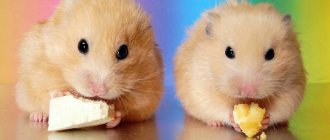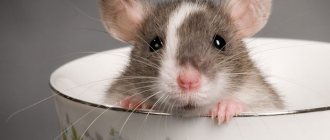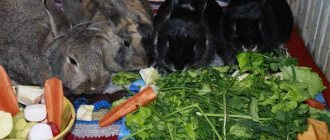Livestock » Rabbits
2
6474
Article rating
Kira Stoletova
To raise healthy and strong animals, you need to know the features of their diet. How many times a day should rabbits be fed? Let's look at what and in what quantity should be given to long-eared animals so that problems do not arise in the future.
Rules for feeding rabbits
Nutrition Basics
It is difficult for novice livestock breeders to understand the intricacies of breeding, so they often make certain mistakes. No need to calculate the ratio of proteins and carbohydrates per month on a calculator. Knowing the basics of feeding can help you avoid trouble.
- Quality products. It is forbidden to feed rotten or moldy food. Soaked, frozen or frost-covered food is a source of disease.
- Varied menu. Even the most delicious diet quickly becomes boring. Rabbits are more sensitive to food, so it is important to offer them a variety of foods.
- Water. Dry food is better digested only with an abundance of fresh liquid. The lack of an important element is first reflected in the form of constipation and lack of milk in lactating females.
- Food is given at a certain time. Animals quickly get used to the schedule and wait for food.
- You cannot feed all groups the same. The daily intake for each type of rabbit is different.
Long-eared animals eat at least 30 times within 24 hours. According to the Mikhailov system, animals have regular access to products. In nature, a rodent constantly finds twigs or grass, so the body receives nutrients in sufficient quantities. In this case, the livestock grows healthy and strong, without a single hint of obesity.
When kept in cells, they necessarily receive not only plant food, but also animal products. Experienced breeders provide fish oil, bone meal and whole milk with whey. It is useful to give silage with the addition of beets, potatoes and concentrate. Be sure to include microelements.
What is feed and how much does a rabbit need?
If it is not possible to give the animal natural food, you can give preference to the most ordinary compound feed. This food contains a balanced amount of vitamins and minerals. It also contains carbohydrates, proteins and fats in the required quantities. In addition, it also contains protein necessary for the rabbit’s body. This type is absorbed by the body for quite a long time, so it should be introduced gradually and over a huge period of time. The most nutritious and useful elements of feed are:
- corn;
- oats;
- barley;
- wheat.
For feeding, these products are very suitable for the animal and give it an incredible amount of energy and strength. Naturally, the best feeding option both in winter and summer is compound feed, although it is quite expensive. It is worth highlighting the following types:
- full-featured;
- special feed additives;
- feed in the form of concentrate.
The complete version of compound feed contains the necessary vitamins and other useful substances in normal proportions, which will be sufficient for the normal functioning of such an animal. Among feed additives, a variety of minerals and vitamins should be highlighted. When introducing such elements into feeding, you should know some of the characteristics of the animal’s body. If there is no normal amount of vitamin A, the rabbit may develop problems with vision and the reproductive system. Vitamin B will help for the functioning of the digestive system. But to maintain immunity at a good level, a decorative rabbit urgently needs vitamin C.
If we consider the so-called concentrate feed, it is a mixture of cereals and legumes. In fact, this is the feeding option that every animal should have. Often it contains almost identical elements, among which you can find bran, yeast, pieces of meat, grains and various vitamins and minerals.
Feeding mode
Rabbits eat very often, so it seems to beginners that the animal is constantly chewing on something. Farmers prefer two meals a day: morning and evening. At home, they practice feeding food three times a day:
- in winter - at 8, 12 and 17 o'clock;
- in summer - at 6, 15 and 19.
Rabbit diet
In cold weather, in the morning and evening, give half the ration of concentrate (grain) and the same amount of silage. At noon it is better to feed with root vegetables. In warm seasons, at the beginning and end of the day, preference is given to dry food (50%) and grass. Dried greens are divided into 3 portions and added each time.
This diet will help to quickly build muscle mass in animals. Always check the availability of drinking water. In cold weather, the liquid must be warmed to room temperature.
Fattening
Meat breeds are raised according to a certain pattern. It is important to not only gain weight in a few weeks, but also get an excellent ratio of meat and fatness. Experienced livestock breeders recommend starting the process 42 days before the expected slaughter.
What and how many times a day should you feed rabbits? More than 50% of the menu consists of concentrates, and to increase fat it is recommended to feed boiled potatoes, corn and barley. Sometimes peas and oats are allowed, and parsley and dill are mixed with hay.
Animals should move less and gain weight faster. To do this, their movement is limited to a cage in which no more than 6 eared heads sit. They are sent to slaughter after the individuals become lazy and have little interest in food.
Diet during mating
To get healthy and strong rabbits, you need to take care of the condition of the future parents. Thin people are provided with enhanced nutrition, and fat people are put on a diet. Too little or too much fat leads to stillbirth and reduces sperm quality in males.
Enhanced feeding of exhausted individuals begins a month before the mating period. It is necessary to increase the daily diet, bringing it closer in nutritional value to the menu of pregnant women. Abundance and variety are complemented by multivitamins.
To improve sperm quality in males, you need to use protein foods. To enrich food, oilseed cake, meat and bone meal and fish meal are added. During the mating period, you should not use products that contribute to obesity, therefore exclude:
- barley;
- corn;
- potato.
The viability of the rabbits depends on the health of the producing animals. It is advised to provide a nutritious and varied diet with a sufficient amount of useful microelements. Veterinary supplements can be used at this stage.
What should a rabbit eat during the rest period? A typical diet consists of one-third grain and 70% hay. Added to food (in grams per head):
- salt - 1;
- bone meal - 4;
- ground shells - 2.
Reviews
Nikolay, 37 years old
We have a large farm, so we specially go to the feed mill to buy feed. To save money, we buy concentrates, which we add to the main diet. We directly pour the granules into the feeders, and we dilute the loose feed and give it out in mash. After switching to specialized feed, our weight gain increased and the quality of the skins improved.
Elena, 29 years old
I have a small decorative rabbit, it eats very little, I buy a full ration of food for it at the pet store. Very convenient: the bag for the animal contains a specially selected composition of vitamins, fiber, proteins, protein, and microelements. There is no need to think about what to feed your pet - just pour granules into a cup, and all problems are solved. After eating, the rabbit is always cheerful and energetic, the fur is smooth and shiny.
In modern rabbit farming, the use of compound feed is a prerequisite for obtaining stable weight gain, high-quality wool and healthy offspring.
Features of the female menu
A pregnant rabbit eats a lot. Obese mothers find it difficult to give birth. Before giving birth, the daily allowance is reduced, but starvation is not allowed. Lack of nutrients leads to a delay in the natural development of the fetus.
One female rabbit eats from 60 to 100 g of plant food (oats, concentrate, legumes) per day. Additionally, add sunflower or soybean cake - no more than a third of the norm. Since there is no lactation yet, half a kilogram of grass is enough.
Don’t forget about carrots and potatoes: 250 g per head. Pregnant females must be given minerals and vitamins, and fish oil and meat and bone meal are suitable as natural supplements. It is important to monitor water quality.
After childbirth, you need to increase lactation. A nursing rabbit eats green grass in the summer, and in cold seasons it is better to feed root crops, hay and silage. Feeding rates increase in the period from 20 to 45 days (in grams per individual):
- mixed feed - 150;
- juicy menu - 300;
- grass - 1000.
Lactating females need to consume 60-70 g of protein per day in food. Their food should contain at least 17-18% of the important product.
The babies watch their mother and soon begin to try adult food themselves. To prevent the rabbit from starving, you need to add 30 g of concentrate and hay to the daily dose in winter, and 25 and 60 g in summer. In this case, you don’t have to worry about a lack of food and a decrease in lactation.
Junk food
Rabbits are herbivores, and therefore green food forms the basis of their diet. However, there are herbs that rabbits should not eat, because... they pose a serious threat to the health and life of animals. The most dangerous: hemlock, hemlock, dog parsley, foxglove, wild radish, celandine, larkspur - all of them are extremely toxic. Hemlock and dog parsley have a detrimental effect on the rabbit's nervous system. Veh and foxglove cause severe disorders of the cardiovascular system. Intoxication with wild radish and celandine is expressed by intestinal bloating, colic, diarrhea, often ending in death (especially from celandine). And larkspur seems to have brought together all those types of negative effects that distinguish the herbs listed above. Larkspur causes disturbances in the functioning of the cardiovascular, respiratory, nervous and gastrointestinal systems (colic, diarrhea, vomiting). No less dangerous are hellebore, spurge, aconite (fighters), lily of the valley, belladonna, dope: they act in the same way as the herbs described earlier.
Qualified assistance from a veterinarian, called at the first sign of poor health in rabbits, will help cope with poisoning of animals with toxic herbs. And it’s better, of course, to try to avoid such incidents...
Features of the young cattle menu
Feeding rabbits has its own subtleties. It is better to place babies in the period from 30 to 45 days after birth. If you are deprived of mother's milk at an earlier age, the digestive system of young people will not have time to form correctly. Any “adult” diet is not suitable for eating crumbs, so everything new is introduced gradually.
Fattening young rabbits
Experienced farmers prefer to use granular concentrate. The daily feed intake for young rabbits is (in grams per head):
- up to 2 months - from 85 to 125;
- up to 90 days - from 130 to 170;
- from week 13 - from 180 to 200.
By the way, the menu can be varied with greens and hay. Feed is reduced to 85%, and the remaining 15% is used for grass. In the morning, give half the daily allowance of dry food, and in the evening add root vegetables to the rest. During the day, it is recommended not to forget about silage. Wet foods are given in such a way that they are eaten within 1.5 hours.
Summer feeding
Warm seasons are a great time to diversify your animal menu. The basis of the diet is both grass and radish and carrot leaves. Eared beetles are good at absorbing branches of fruit tree varieties. It is not prohibited to offer apples, cabbage and waste from them.
Sugar and red beets should not be given in large quantities. Products cause increased gas formation, which leads to bloating. It is allowed to use fodder types of root crops. To improve digestion, give fragrant herbs:
- sagebrush;
- dill;
- yarrow;
- chicory.
Dried garlic stalks are used to prevent dental problems, and plantain is a natural antibiotic. Young nettle will become a natural source of vitamins. By the way, such a delicacy can be given to both a nursing rabbit and meat rabbits.
How much greenery is allowed per pet? On average, adults eat up to 600 g of grass, rabbits - from 150 g and more. Keeping lactating mothers allows you to increase the norm by 2 times. Using this type of diet reduces the consumption of dry food and saves concentrates.
Winter feeding
During cold seasons, animals often experience vitamin deficiencies. Microelements A, D, E and B12 must be added to the daily food intake for rabbits. High-quality hay and fermented green food will provide the body with important components. Fish oil is added once a day (in grams per head):
- rabbits - 0.5;
- lactating females - 3;
- pregnant women - 2;
- for other animals - 1.
Sprouted grains are rich in vitamin E, so they are regularly given to both children and adults. If you don’t have time to grow greens, then sometimes you can replace them with yeast. For 5 days, one individual is fed up to 6 g of baking product. Then they take a break for 72 hours and repeat again.
What to feed rabbits in winter
Turnips, cabbage and dry grass are fermented in barrels for the winter. Add carrots and salt (1% of the total mass). An adult animal should have no more than 300 g of such food, while 100 g per head is enough for young animals. To prevent vitamin deficiency, experienced farmers sometimes give needles of coniferous crops.
How much should a rabbit eat in winter? During this period, 50% of the total diet consists of concentrates, and the rest is silage and succulent foods. Carbohydrates that can be obtained from boiled root vegetables are perfectly absorbed.
Types of feed
Compound feed for rabbits is divided into:
- loose;
- granular (extruded).
Loose feed is a powder. Its disadvantage is the “dustiness” which can irritate the respiratory tract of animals. Used mixed with other types.
Granular - consists of pressed granules, which are much more convenient than powder. This type of feed is easier to store, transport and measure for rabbits. Less susceptible to damage. This is what experienced farmers buy first.
Depending on the concentration of nutrients, combined feeds are divided into:
- Complete - can make up 100% of the diet and fully satisfy the needs of animals;
- Concentrated – contain increased amounts of proteins, vitamins and nutrients. They are used as an additive to the main menu and reach up to 50% of the main diet.
- Feed mixtures – designed for farmers to mix feed themselves. Contains proteins, vitamins, minerals and proteins. The recommended amount is 20% of the daily feed.
- Premixes - contain only active additives for the growth of rabbits: stimulants, amino acids and vitamins. No more than 1% of the entire diet.
The type of feed chosen directly depends on the needs of the animals, the goals of farmers and their financial capabilities.
It is worth creating special conditions for storing feed
Things to remember
Long-eared pets love to chew on something, so you need to be careful about food of animal origin. Dairy products are included in the menu in limited quantities. For one individual, 10 g per day is allowed, which is used both raw and added to mash.
The rabbit must eat grain, but experienced farmers advise pre-grinding large grains in a crusher. Such food is easily digestible and does not cause rejection in young animals. During feeding, you need to carefully monitor your pet’s taste preferences and not let unloved ingredients be scattered.
Eared animals should not eat fresh bread. It is better to cut the product into small pieces and dry it in the oven. Crackers are used as an additional treat. Do not get carried away with table waste and give food with an abundance of spices and salt.
Autumn and spring are a period of transition from one type of food to another. It is not recommended to carry out the procedure abruptly, otherwise it can cause digestive problems. Gradual introduction of new types of food should be done over 7 days. If diarrhea begins, then the animals should be given oak branches.
Knowing the daily feeding rates for rabbits per head, you can accurately calculate the consumption of a particular product per month. Our recommendations will help you find the optimal menu for each stage of animal life. Thanks to knowledge of seasonal characteristics, it is easy to adjust your diet.
Feed storage
To obtain greater benefits and material benefits, you need to think about the proper storage of feed and prevent its spoilage.
The main problems of improper storage:
- Infestation by harmful insects and mold. The bran and grains included in the composition are a favorable environment for them.
- Loss of nutritional properties of vitamins and minerals.
- Poisoning or infection of animals in the presence of harmful bacteria.
To prevent such phenomena, special conditions for storing feed are created in livestock farms. Some of them can be used in small farmsteads:
- the presence of a dry, ventilated room;
- avoiding dampness and direct sunlight;
- fight insects and rodents;
- read and follow manufacturers' recommendations;
- observe the expiration dates of the feed.











